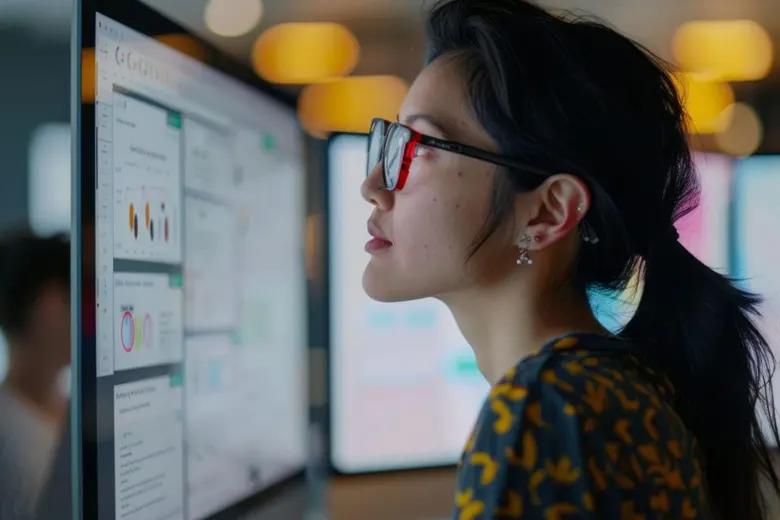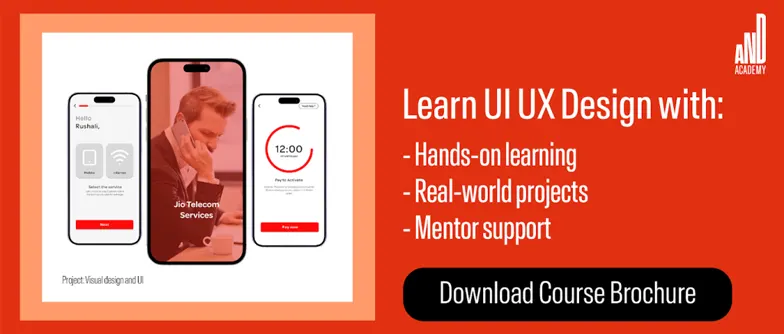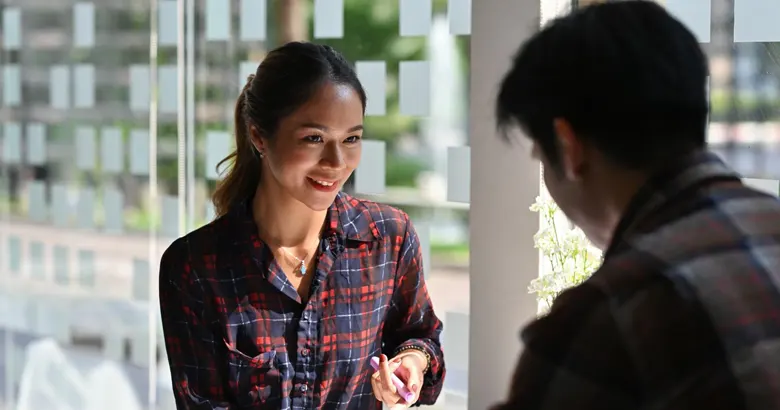Learn what each part of the UX designer job description means for your application alongside a walkthrough of some real-world examples
If you’re looking for a job in UX design, you may have come across UX designer job descriptions on job boards, social media sites, and company websites from organizations looking to fill vacancies. But while finding job vacancies in the field may be fairly straightforward, knowing what exactly these job descriptions are looking for from prospective candidates can sometimes be hard to gauge.
In this article, we’re here to help with just that. We break down the UX designer job description into its various parts, run you through what each section means, and summarize what the company is asking of you. By the end, you’ll feel confident in knowing how to address all the elements of a job description and be able to prepare a persuasive and professional application that leads to success.
Contents:
- What does a UX designer do?
- Roles and responsibilities of a UX designer
- How does the role of a UX designer vary from company to company?
- Specialist UX design roles
- Common components of a UX Designer job description
- Examples of real UX designer job descriptions
Ready to learn more? Then let’s dive straight in!
What does a UX designer do?
The role of the UX designer is to create products and services that are intuitive and delightful for users to interact with and help them reach their goals. They do this by delving into the needs, behaviors, preferences, and desires of target audiences before using the data gathered to inform design decisions. To uncover the data they need, a UX designer will conduct user research, develop user personas, create wireframes and prototypes, and test designs. Ultimately the UX designer seeks to bridge the gap between user needs and business goals, ensuring that the final result is effective in what it sets out to do while offering a seamless user experience.

What are the main roles and responsibilities of the UX designer?
The roles and responsibilities of a UX designer will vary depending on the company, the size of the design team, and the project or projects being worked on. However, as a general rule, the main roles and responsibilities of UX designers are as follows:
- Create innovative solutions to address product and user challenges, working with mobile, desktop, physical environments, and in-person interactions
- Contribute to planning and defining strategy for future design iterations
- Perform user research into user needs, behaviors, and paint points
- Create and iterate on user personas, customer journey maps, and scenarios to inform the decisions of the design team
- Develop high-level, detailed storyboards, wireframes, mockups, and prototypes to convey a design and user interactions
- Perform testing and collect feedback to inform and refine designs
- Review and optimize the performance of new and existing features informed by performance metrics and user research
- Work across different teams such as marketing, business, and development
- Collaborate with UI designers and product managers throughout the production cycle
- Ensure brand guidelines and business objectives are adhered to
- Conduct in-depth analysis of data from research and testing and apply findings to all design decisions
- Be engaged in the UX design community at large, stay updated on the latest tools and trends, and be active in learning about the topic
- Contribute to the design team’s shared knowledge of UX design practices
- Advocate for a user-centric approach company-wide
- Be a proactive member of design reviews, offering feedback and constructive criticism
How does the role of the UX designer vary from company to company?
As with many job roles, the size, resources, and needs of the company contribute significantly to the responsibilities and tasks of its UX designers. A UX designer working at a startup or small family business may be required to perform the entire UX design process from start to finish single-handedly for every project. This is because a small firm is unlikely to be able to invest heavily in employing an entire design team. Wearing multiple hats, the UX designer in this case may be expected to conduct initial user research, data analysis, wireframing and prototyping, testing, and design implementation. They may even be expected to have skills related to front-end development or visual design.
In contrast, a large corporate or established organization can employ experts for each stage of the UX design process, investing time and resources into multiple projects that are simultaneously ongoing. An organization will typically employ a large team of designers who each take on different tasks and responsibilities as required by a project. UX designers in such roles are likely to have specialist knowledge of different areas of the UX design process, such as information architecture or interaction design, and work closely with other topic experts within their specialist area alone.
In addition to the size of the company and its design team, other factors that will impact the role of the UX designer include the company’s:
- Focus on user-centricity
- Maturity of its design processes
- Business priorities

Specialist UX design roles
Let’s take a look at four common UX design roles and the key responsibilities you’ll often find mentioned in their job descriptions.
UX researcher
As the name suggests, a UX researcher collects data on the needs, behaviors, motivations, pain points, and preferences of a product or service’s users. These findings are then translated into actionable design recommendations that help the design team make informed decisions and produce products that are more user-friendly and effective.
A UX researcher is required to harness a number of different strategies and methodologies to gather the quantitative and qualitative data they need. These practices include interviews, surveys, usability testing, and data analysis. UX researchers rarely work in isolation. In addition to working closely with users, they are typically part of a larger team of UX designers, product managers, and project stakeholders, making it a role that often demands collaboration skills.
Interaction designer
Focusing on human-computer interactions, an interaction designer creates intuitive and engaging experiences for users with their digital devices. A key responsibility held by the role involves defining how users interact with a product. The interaction designer uncovers this information by closely examining the behavior of users with interactive elements such as buttons and menus, navigation systems, workflows, and task flows.
The goal of the interaction designer is to ensure user experience that is visually appealing, functional, and intuitive to use. They are needed to create wireframes, prototypes, and mockups to convey their concepts to other UX designers, UI designers, developers, and product managers who implement and refine these interactions based on the results of testing and user research. Irrespective of the digital device the information is being accessed with, the interaction designer seeks to ensure a responsive, accessible, and seamless experience, and a job description for the role will often prioritize this skill.
Information architect
The information architect heads the organization and structuring of website and app content with the goal of making it as understandable, navigable, and accessible to users as possible. Concentrating on an interface’s structural design, they seek to group, label, and connect different pieces of information through sitemaps, navigation systems, and categorization schemes.
As we have seen with some of the other roles outlined here, the information architect does not work alone. They belong to a team of UX designers, content strategists, and engineers who collectively align the way information is presented, labeled, and organized with the needs of the user and business without impeding the overall experience. For content-heavy apps and sites in particular, this is an important role. Not only does the information architect ensure information is organized in a clear and digestible way, but they also contribute significantly to overall usability and user satisfaction, too.
UI designer (or visual designer)
The UI designer (sometimes known as a visual designer) is a member of the design team who is responsible for the aesthetic of an interface. Professionals in this role are expected to create visually appealing layouts, choose brand-appropriate color schemes, and select the right typography, icons, and other design elements that align with the message of the content.
Like many of the other UX designer roles we’ve looked at, the UI designer job description will often focus on the ability to develop wireframes, mockups, and prototypes of user-friendly and eye-catching designs that guide engineers as they program an app or website. By working closely with UX designers, the UI designer ensures that an interface does not only attract users but also aligns with the user journey, and bolsters understanding, usability, and accessibility.

Common components of a UX designer job description
A look at the different sections you’re likely to see on a UX designer job description, the purpose of each one, and an example of the text it may contain.
Job summary
The purpose of this section
This Job Summary section of the UX designer job description provides interested applicants with a high-level overview of the role and the scope of the position. Applicants should come away with a good idea of what the role entails, its place within the design team, and its position within the organization as a whole. This section should be fairly short to enable applicants to swiftly gauge if the role is a good fit for them, their experience, and their career goals before they read more about the position and the company. Details regarding the specific tasks and responsibilities expected of the role, as well as information about the organization, typically follow in the next section.
Example of what you’re likely to see here
DoubleCloud is looking for a UX Designer to join our Product team and help us create intuitive and user-centric services. Our perfect candidate is a self-motivated individual who can lead a team to shape and structure our UX vision and product. If you are passionate about solving large and complex tech challenges and want to help innovative companies use data in groundbreaking ways, we’d love to have you on board. Come join us and be a part of something amazing!
Key responsibilities
The purpose of this section
The Key Responsibilities section on the job description is the place for the core duties, tasks, and responsibilities of the role to be communicated. Usually formatted as a list, the key responsibilities convey both the activities that the UX designer will be expected to perform on a daily basis and what they should be aiming to achieve at the organization over a longer period. By outlining specific functions and duties in this way, companies enable prospective candidates to fully understand the role they are applying for and assess how well the job aligns with their own experience and aspirations. Candidates are wise to refer to these key responsibilities when applying for positions. This is because highlighting their experience taking on similar responsibilities and tasks in previous roles is an effective way of demonstrating their suitability for the role.
Example of what you’re likely to see here
- Conceptualize original ideas that bring simplicity and user-friendliness to complex design requirements
- Execute all visual design stages from market research, through ideation and hand-off to engineering
- Closely communicate and collaborate with relevant engineers
- Create wireframes and mockups with specifications to effectively communicate interaction and design ideas
- Conduct user research and evaluate user feedback
- Establish and promote design guidelines, best practices, and standards
- Manage delivery timelines, resources, and risk assessments
Required skills
The purpose of this section
The Required Skills section on the job description is where a potential employer will outline the exact skills and experience they are looking for in candidates. It will usually include technical skills such as prototyping and soft skills such as collaboration. On many job descriptions, this section is combined with the tools and technologies that candidates should be proficient in. It may also include the level of education candidates will be required to have to succeed in the role.
Example of what you’re likely to see here
- Degree in design, interaction design, or a related field is preferred.
- UI/UX design experience with a strong portfolio and excellent visual design skills
- Proficiency in design and prototyping tools such as Figma or Penpot
- Up-to-date with the latest UI trends, techniques, and technologies
- Analytical skills and ability to work in a complex environment
- Can-do attitude and solution focus as well as commitment and strong work ethic
- Excellent communication skills in English, additional languages beneficial
Tools and technologies
The purpose of this section
Some organizations will separately list the tools and technologies that applicants should be familiar with in the job description. This section usually includes the software, platforms, and other technical resources used by the current design team. By listing these tools, organizations are communicating their tool preferences and candidates are clear from the outset the technology they should be proficient in should they land the job. It’s also a good indicator of the tools applicants should demonstrate using in their portfolios and on their resumes. You can check out this UI UX Project by AND Learner Vinay Bandi to get inspiration for your next project.
Example of what you’re likely to see here
- Proficiency in UXPin, Balsamiq, InDesign, and Figma
- Some experience using Sketch and Adobe XD
Educational requirements
The purpose of this section
Employers will be keen to communicate what’s required of candidates when it comes to their educational backgrounds. That’s what this section is for. While some teams will be looking for a UX designer with a degree, others will be satisfied with applications from those who have undertaken specialized training or completed specific UX-related courses. For some organizations, experience in UX may be favored over education, however, others will want to see certification as proof of a certain standard of UX design knowledge and commitment to this career choice.
Example of what you’re likely to see here
- Bachelor’s degree in UX Design, Graphic Design, Human-Computer Interaction, or a related field.
- Certification in UX/UI design (e.g., Nielsen Norman Group) is a plus.

Examples of real UX designer job descriptions
Let’s take a look at some real-world examples of UX designer job descriptions.
Example 1: FactFinder
YOUR MISSION
- Work with product and engineering to deliver consistent, intuitive experiences across our products
- Understanding custoreal-worldthrough research and analytics
- Work with internal stakeholders and customers to improve the user experience
- Contributing to product and feature concept development using UCD practices
- Design end-to-end workflows, mock-ups, and visual solutions
- Support in-app user guidance design and workflows
YOUR PROFILE
- 3+ years of experience in designing web applications
- Possess a solid foundation of the design process, methodology, and user-c,entered design
- Expert proficiency in craft software (e.g. UXPin, Balsamiq, InDesign, Figma)
- Fluency with using analytics, user testing & research to inform creative processes
- Demonstrate experience facilitating workshops, managing stakeholders
- Champion the client and represent the voice of the customer at every opportunity
THE JOY OF WORKING WITH US
- Scale-up company with a market-leading product
- Open culture with diverse international teams
- Flexible working hours
- Statrepresent equipment
- Personal development support, e.g. access to the learning platform Udemy
- Regular feedback rounds
JOB LOCATION
Berlin, Pforzheim, remote within Germany
ABOUT US
FactFinder is the European leader in eCommerce product discovery and search. Using authentic intelligence, the unique combination of artificial and human intelligence, FactFinder understands every shopper’s intent from the first click – increasing conversions and boosting revenues by over 30%.
For over two decades, FactFinder has been trusted to support billions of search queries a year, for thousands of B2B and B2C brands including Intersport, White Stuff, OBI, Stihl, and MyTheresa. FactFinder is headquartered in Germany, with offices in Berlin, London and Stockholm.
Source: LinkedIn
Example 2: ZEAL Network SE
About us:
ZEAL Network SE is an international, listed group of companies that has been creating exciting and entertaining lottery experiences for over 20 years. In Germany, we are the largest provider of online lotteries through our brands, LOTTO24 and Tipp24. In Spain, we work with the second-largest national lottery, ONCE. Through ZEAL Ventures, we are involved in exciting e-commerce start-ups such as Omaze and DAYMADE. We have 180+ employees from various countries who act independently and think in a visionary way. Our corporate culture is characterized by team spirit, empowerment, and high ambition. Together we have a clear goal: to encourage people to dream.
Sounds like you? Great! We are looking forward to your application!
What we offer:
- You are part of a cross-functional team and take over the UX responsibility for the entire e-commerce experience of a new product.
- We foster a culture of continuous learning and bring in new expertise.
- We value open feedback and support your professional and personal growth.
- You can shape the UX practices within the company thanks to our small, self-organized UX team.
- You can test your ideas in our weekly (nowadays mostly remote) user evaluations in various formats.
- No micromanagement, but a lot of trust in your ability to deliver and perform
- A yearly development budget of EUR 1,500,- for your personal development
- Independent and innovative way of working and a belief in real flexible work. You can take your unlimited vacation days spontaneously; we work in a hybrid model and provide you with technical home office equipment.
- Once a quarter a company event where we all get together and celebrate, as well as regular team events and small get-togethers
- Challenging tasks and lots of fun!
Your tasks:
- You create and manage the entire e-commerce experience for our games domain by mapping experiences and journeys and creating concepts, flows, and prototypes.
- You support our game production team with in-game UX and UI topics by visualizing features and optimizing existing solutions.
- You collaborate with your PM, engineers, UX and User research colleagues, and data experts.
- You identify customer needs and generate ideas within your team, all while keeping an eye on product metrics (KPIs) and working based on hypotheses.
- You gather feedback and validate your ideas in collaboration with user research and data analytics.
- You communicate your work effectively and collaborate with your colleagues to put ideas into action and iterate on them.
What you offer us:
- You are passionate about digital product development and user-centric work.
- You show a genuine interest in the domain of gaming and gambling, especially instant-win games and online virtual slots. Former experience in the iGaming industry is a plus.
- You embrace innovative ideas, think holistically about UX, and have solid experience in e-commerce.
- You are creative with a strong conceptual thinking and know common UX tools and methods.
- You are a team player with a can-do mentality aneager to drive the design processes.
- You also have a keen eye for visual representation and experience in UI Design? That’s a strong plus!
Source: LinkedIn
Example 3: Exmox
Exmox, headquartered in Hamburg, is an innovative AdTech company dedicated to crafting the next generation of performance marketing products. Our mission is to seamlessly connect advertisers with their most valuable users through our proprietary products. What sets us apart is our unique business model, centered around rewarding users for testing and actively engaging with our client’s products.
At Exmox, we take pride in our dynamic approach and client portfolio, counting some of the industry’s largest mobile gaming companies among our valued clients. As we navigate the exciting scale-up phase, we are actively seeking ambitious individuals who are passionate about contributing to our growth.
Are you ready to make a meaningful impact? Join our expanding team and play a vital role in shaping the future of performance marketing. Together, let’s explore new frontiers and redefine the possibilities in this dynamic industry.
Tasks
As a UI/UX Designer at Exmox, you’ll find this opportunity to be an incredible learning experience. You’ll be an integral part of our team, playing a critical role in shaping our products and guiding their future direction. Your contributions will be highly valued and will have a significant impact on our success.
- You create wireframes, interactive prototypes, and mockups to visualize design concepts.
- You communicate design concepts and reasoning effectively to stakeholders.
- You write well-described user stories documenting design specifications for developers.
- You conduct competitor analysis to identify strengths and weaknesses in existing products and user research, including interviews, surveys, and usability testing.
- You ensure consistency in design solutions and ensure designs comply with brand guidelines.
- You pivot on designs based on feedback from stakeholders and users.
- You perform design reviews. Making sure implementation is aligned with designs.
Requirements
You have:
- A well-prepared portfolio showcasing your work.
- An academic degree in design, human-computer interaction, computer science, or a related field.
- At least 4 years of relevant experience in creating and implementing UI/UX design for mobile and strong visual design skills to work on B2C products.
- You are proficient with visual design programs such as Figma and its latest features.
- You have great experience with creating and maintaining design systems.
- You are able to produce and maintain well-written documentation and user stories.
- You are experienced in graphic design, including designing icons, vectors, illustrations, and respective tools. Preferably, your portfolio showcases your work samples.
- You are familiar with how CSS works.
You are a team player with:
- Empathy and excellent social, communication, and presentation skills.
- The willingness to work effectively in a fast-paced, agile environment.
- The ability to deal pragmatically with uncertainty and ambiguity.
Source: LinkedIn
Conclusion & Next Steps
And there you have it! A complete guide to fully understanding UX designer job descriptions and some real-world examples of what you can expect to find when you start your job search. We hope that, with these insights, you feel more confident in knowing how to prepare your UX designer job applications and find success in the field.
If you’d like to learn more about UX design, head over to the AND Academy blog for more articles like this one.
In case you think you need further assistance, here are some of our resources you can consider:
- Watch this session by Shiva Viswanathan, Design Head of Ogilvy Pennywise, and Naman Singh, Product Experience Designer at RED.
- Talk to a course advisor to discuss how you can transform your career with one of our courses.
- Pursue our UI UX Design courses – all courses are taught through live, interactive classes by industry experts, and some even offer a Job Guarantee.
- Take advantage of our scholarship and funding options to overcome any financial hurdle on the path of your career transformation.
Note: All information and/or data from external sources is believed to be accurate as of the date of publication.









